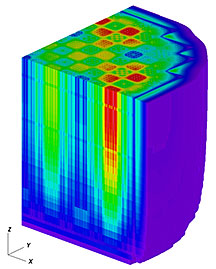- Number 393 |
- July 22, 2013
Innovation Hub's reactor simulation model uses utility's data

This CASL visualization shows the
thermal
distribution of neutrons in
Watts Bar Unit 1
Cycle 1 reactor core
at initial criticality, as
calculated by the
VERA program.
Scientists at the Consortium for Advanced Simulation of Light Water Reactors have successfully completed the first full-scale simulation of an operating nuclear reactor. CASL, headquartered at DOE's Oak Ridge National Laboratory, is modeling nuclear reactors on supercomputers to help researchers better understand reactor performance with much higher reliability than previously available methods, with the goal of ultimately increasing power output, extending reactor life, and reducing waste.
Simulation results from the Virtual Environment for Reactor Applications (VERA) program, developed by CASL, were compared with actual data provided by the Tennessee Valley Authority's (TVA) Watts Bar Nuclear Plant in Tennessee, which confirmed its accuracy.
"VERA's capabilities range from simulating single fuel pins to modeling an entire operational reactor core," said Jess Gehin of ORNL's Reactor and Nuclear Systems Division. "It addresses operational challenges and supports increased power generation by exploring greater efficiency and life extensions."
During cycle startup of commercial nuclear power reactors, technicians perform a series of tests to confirm the reactor is operating as expected. For CASL, results of previous tests are useful for demonstrating the accuracy of the VERA software. As a CASL partner, TVA provided detailed historical information and measured operational data from the Watts Bar plant to allow comparisons of the VERA simulation.
The simulations of the reactor startup tests are just a first step in the demonstration of VERA. CASL is extending the program's capability to simulate full power operation of the TVA reactor, which will require further VERA development to integrate the nuclear and thermal hydraulic physics. These additional capabilities will allow researchers to pursue breakthroughs in understanding key phenomena in the operating reactors.
CASL is one of DOE's Energy Innovation Hubs. First established in 2010, CASL brings together industry, academia, and national labs to provide advanced modeling and simulation solutions for commercial reactors. Its mission is to confidently predict the performance of nuclear reactors through comprehensive science-based modeling and simulation technology that is deployed and applied broadly throughout the nuclear energy industry to enhance safety, reliability and economics.
The Hub's 10 core partners include: the Electric Power Research Institute, Idaho National Laboratory, Los Alamos National Laboratory, Massachusetts Institute of Technology, North Carolina State University, Sandia National Laboratories, Tennessee Valley Authority, University of Michigan, Westinghouse Electric Company and Oak Ridge National Laboratory. More information about CASL is available at http://www.casl.gov.Submitted by DOE’s Oak Ridge National Laboratory
